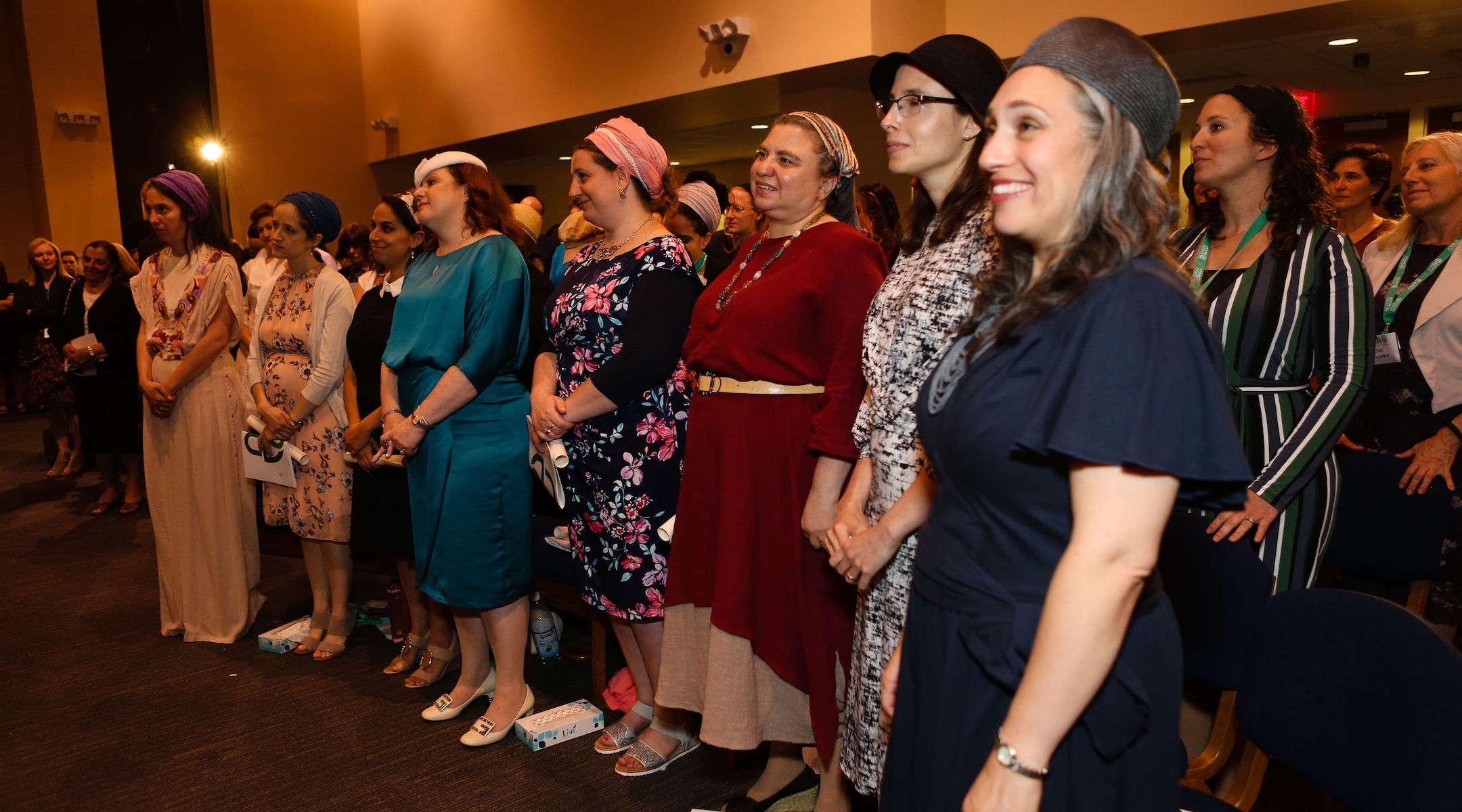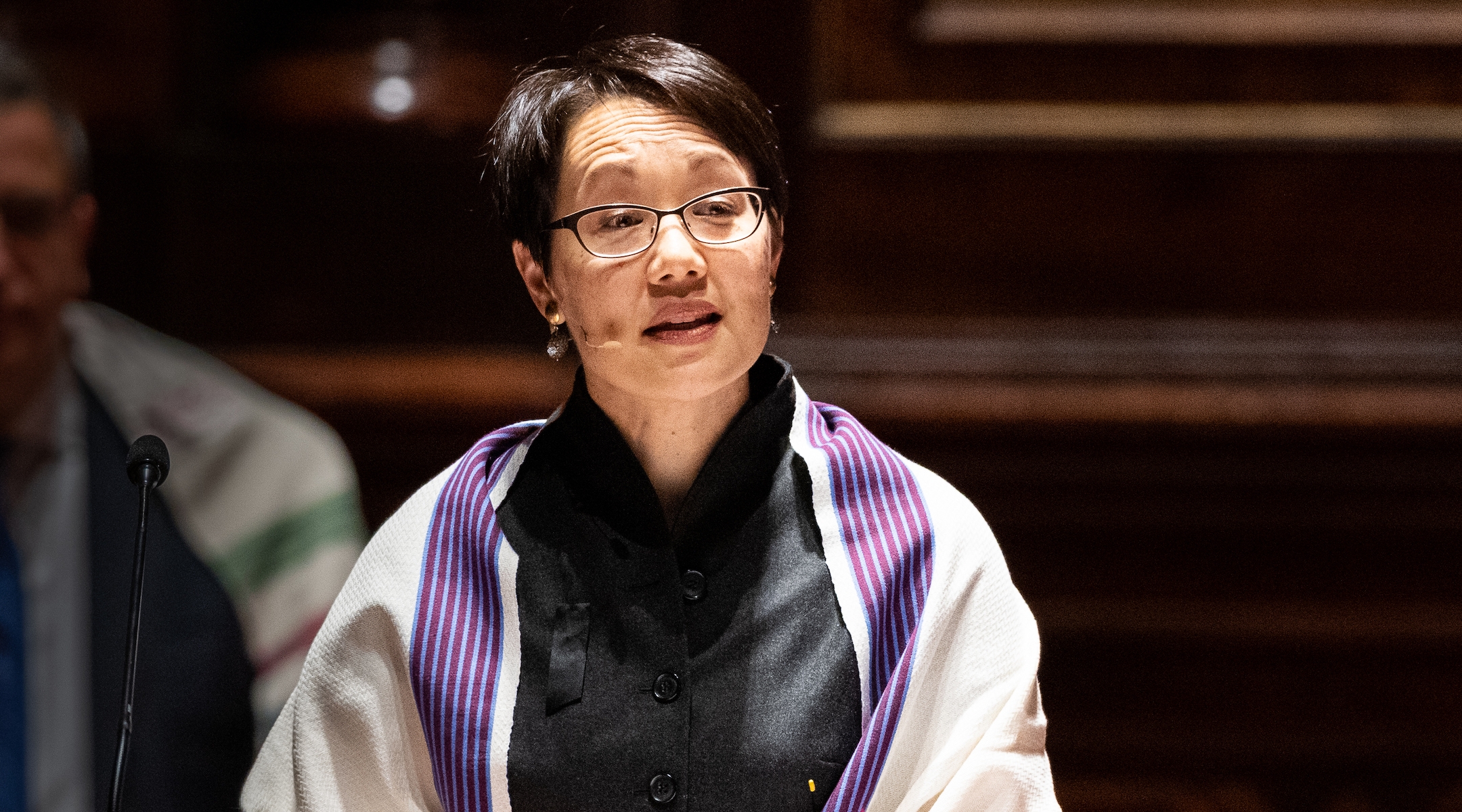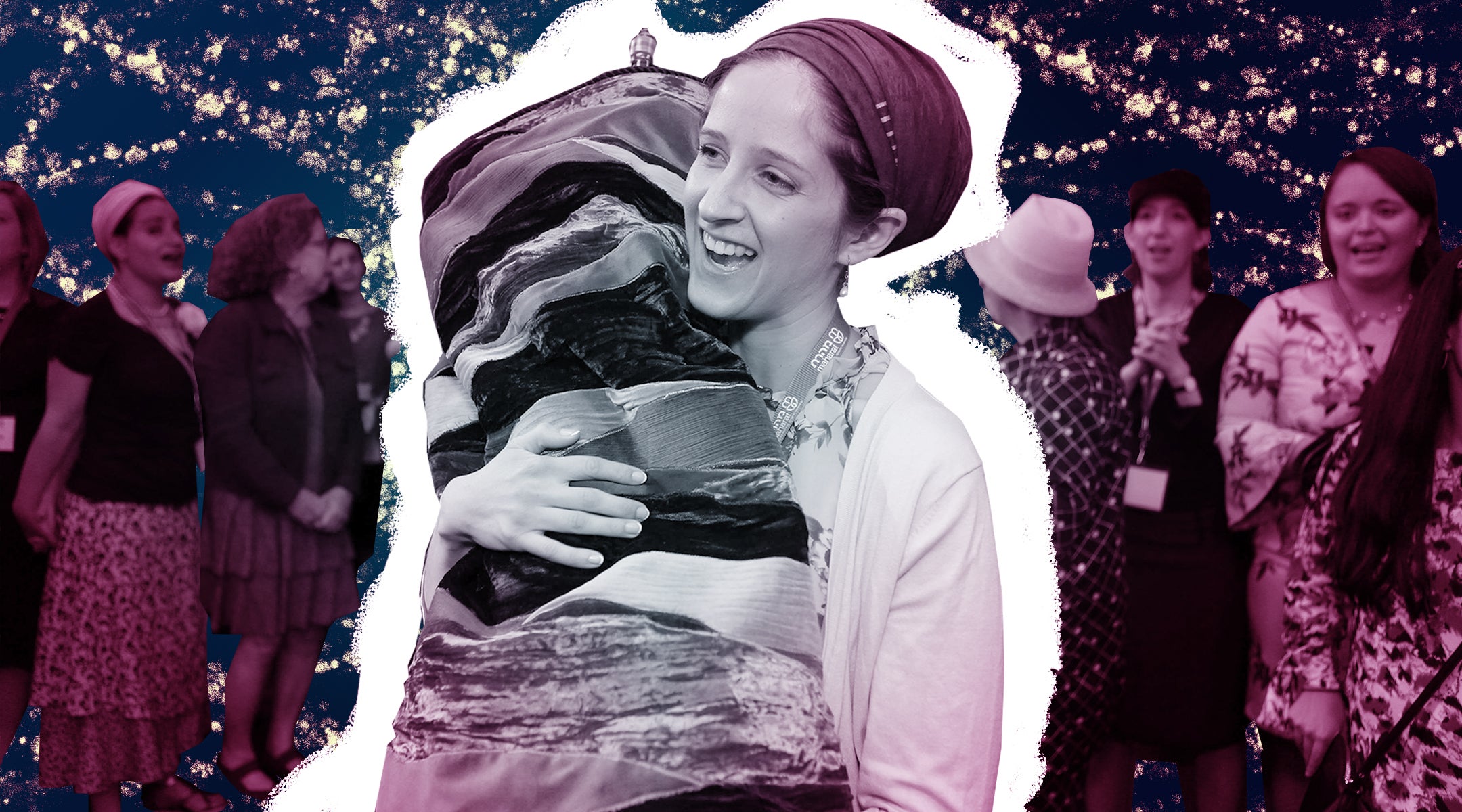NEW YORK (JTA) — All of the gloom and doom that many in the Jewish community have felt toward the end of this decade should not obscure the fact that the 2010s were full of innovation. Yes, there was an alarming rise in anti-Semitism across the U.S. and the world, which culminated in several violent attacks on Jews and Jewish institutions. But that didn’t stop the community from growing, evolving and adapting to modern life.
Here’s a look back at 10 huge developments from the past 10 years that have changed the makeup and lifestyles of Jewish Americans.
Technology puts Judaism in everyone’s pocket

(Stevica Mrdja/EyeEm/Getty Images)
With the advent of the smartphone, we modern folks have grown accustomed to having any piece of information available anywhere, anytime, at the push of a button. But it wasn’t until the launch of Sefaria in 2011 that this was true of Jewish texts.
In a stroke, Sefaria put thousands of years of Jewish literature in everybody’s pocket. The Bible, the Talmud, medieval Jewish philosophers and commentators, the classic Jewish legal codes — all of it available in Hebrew (and often English, too) and completely searchable. Seemingly overnight, the site became an invaluable resource for Jewish learning. And much like Google and Facebook before it, Sefaria made many people wonder how they had ever lived without it.
The site also helped democratize Jewish study — not only by making English translations of canonical texts instantly available anywhere, but by making it possible for anyone to create source sheets that gathered sacred texts on a given topic and share them with the world. The site currently hosts thousands of such sheets on topics as diverse as Jewish business ethics, discrimination, civil rights, hunger and environmentalism.
Sefaria is not the only example of technology being harnessed to broaden the Jewish tent. Synagogues now stream services for free online and Jewish educational websites bring a bottomless wealth of Jewish information to the far-flung masses. But it may be the most ambitious of the lot.
— Ben Harris
A new kosher cheeseburger becomes possible

Impossible burgers shown at a medida event in Las Vegas, Jan. 7, 2019. (Robyn Beck/AFP via Getty Images)
The 2010s have seen the emergence of plant-based products that taste eerily like burgers but do not contain an iota of meat. Their purveyors — Impossible Foods and Beyond Meat chief among them — hope to launch a vegetarian revolution that will take down America’s massive factory farming industry. Impossible says that the protein heme gives their offerings the juicy, meaty quality missing from previous veggie burger attempts.
For Jews, the new meatless burgers have meant that dishes once Jewishly verboten have finally become accessible. Observant Jews can slap a slice of cheddar on an Impossible burger and enjoy a 100 percent kosher cheeseburger. At Dunkin’ Donuts, patrons can have an egg with Beyond Bacon.
For kosher-keeping Jews, trying to imitate forbidden foods is a tradition as old as time. Meatless burgers have ushered in a new era of that struggle. For while the rabbis of the Talmud outlawed the eating of milk and meat together, they said nothing about milk and heme.
— Ben Sales
Female Orthodox clergy make their mark

Yeshivat Maharat students attend a graduation ceremony in New York, June 17, 2019. (Shulamit Seidler-Feller/Yeshivat Maharat)
When the decade began, there were almost no American Orthodox clergywomen. When it ended, there were 33.
The 2010s saw a revolution in the Modern Orthodox world, as a seminary for Orthodox women, Yeshivat Maharat, turned out ordained graduates year after year starting in 2013. The last graduating class was the largest with eight members.
The graduates — some of whom take on variations of the title “rabbi” — have made a splash. Nine work in synagogues, many in pulpit positions. The others work in leadership roles throughout the Jewish world. They’ve also sparked a backlash, with two umbrella Orthodox groups — the Orthodox Union and the Rabbinical Council of America — issuing bans on female clergy.
But the bans have not stopped the growing ranks of American Orthodox women receiving ordination, joining the ranks of Conservative and Reform women who have been rabbis for decades. Just months before the decade ended, a graduate of Yeshivat Maharat founded the first-ever American Orthodox synagogue led by a woman.
— Ben Sales
Domestic anti-Semitism is back

People gather in front of the Monsey house of Rabbi Chaim Rottenberg, the site of an attack at a Hanukkah party by a machete-wielding man, Dec. 29, 2019. (Stephanie Keith/Getty Images)
In 2013, the Anti-Defamation League reported the lowest levels of anti-Semitism since it started tracking the phenomenon in 1979. By 2018, the trend had fully reversed: There were 1,879 anti-Semitic incidents, the third-highest total ever recorded by the ADL. The incidents included the killing by a white nationalist of 11 worshippers at the Tree of Life synagogue in Pittsburgh — the deadliest anti-Semitic attack in U.S. history.
Not even a year later, on April 27, 2019, a woman was killed and three others were injured at a Chabad synagogue in Poway, California. And on Dec. 10, four people were killed in an attack that ended at a kosher supermarket in Jersey City, New Jersey. On Dec. 29, a man entered a rabbi’s house in Monsey, New York, with a machete and stabbed five people.
The spike included a dramatic increase in attacks on predominantly Hasidic men in Brooklyn, who are more easily targeted by would-be assailants than other Jews because of their distinctive dress. Jewish Americans are afraid of this becoming the new normal: Some 31 percent of respondents to a recent survey by the American Jewish Committee agreed that they “avoided publicly wearing, carrying, or displaying things that might help people identify you as a Jew,” and 25 percent “avoid certain places, events, or situations out of concern for your safety or comfort as a Jew.”
— Laura E. Adkins
The Pew study counts American Jews

The Pew study found new high rates of intermarriage in the Jewish community. (iStock/Getty Images)
The Jewish organizational world was rocked in 2013 by the release of a study by the Pew Research Center on American Jewish demographics. The study counted how many of us there were, whether we were marrying other Jews, what denominations we identified with and how we observed Jewish ritual. It found that that the rate of intermarriage was sharply rising, the number of Conservative Jews was falling and nearly a third of Jews were unaffiliated.
Since its publication, the study has been used by Jewish journalists, activists and leaders to guide their decisions and justify their opinions. It has also helped push Jewish organizations to shift from trying to prevent intermarriage to trying to engage interfaith families.
The study additionally found that many define their Judaism around remembering the Holocaust, leading an ethical life and working toward justice. It showed that most Jewish Americans feel some attachment to Israel. And it found that nearly all Jewish Americans — 94 percent — are proud to be Jewish.
— Ben Sales
The rise of Jewy and Israeli TV

Abbi Jacobson and Ilana Glazer at an event for their series “Broad City” at Sony Hall in New York City, March 27, 2019. (Dave Kotinsky/Getty Images for Comedy Central)
Jews have long found success in Hollywood, and for decades television has been fertile ground for Jewish cultural references (see: Seinfeld, Jerry). But the 2010s saw the rise of a number of celebrated television shows and movies that are either explicitly centered on Jewish themes or imported directly from the Jewish state.
The Golden Age of Streaming brought a deluge of parochially Jewish shows that still found a mass audience: “The Marvelous Mrs. Maisel,” which won a raft of awards portraying a Jewish 1950s housewife turned comedian; “Broad City,” the comedy about two Jewish millennial women in Brooklyn; “Crazy Ex-Girlfriend,” in which protagonist Rebecca Bunch engages in a “JAP Battle”; and “Transparent,” about a Jewish family in Los Angeles struggling with gender identity and which filmed a season mostly in Israel.
While “Transparent” went to Israel, a number of Israeli shows came to the U.S. Americans binge-watched “Srugim,” about Modern Orthodox singles in Jerusalem; “Shtisel,” about ultra-Orthodox singles (and marrieds) in Jerusalem; “Our Boys,” about the murders of children in and around Jerusalem; and “Fauda,” about Israeli commandos in the West Bank. There were also a bunch of forgettable movie dramas about Israel, at least three of them starring Ben Kingsley.
All of it added up to viewers across America watching and enjoying a range of Jewish characters, foibles and stories.
— Ben Sales
Haredi women have their say

Judge Rachel Freier offers her business card in the New York City Council chamber. In November 2016, Freier became the first Hasidic woman in U.S. history to be elected to public office. (Andy Katz/Pacific Press/LightRocket via Getty Images)
On Dec. 22, 2016, Rachel “Ruchie” Freier was sworn in as a civil court judge in Kings County, New York: She was the first Hasidic woman ever elected to public office in the United States.
Unlike some other segments of the wider Orthodox world, Hasidic Jews largely reject engagement with the secular world unless necessary. Both men and women follow restrictive dress codes, and women in particular are not encouraged to hold public leadership positions.
Raised in a Hasidic enclave in Brooklyn, Freier in recent years has become a symbol of female Orthodox women who want to assume more public roles without compromising traditional values or severing ties to their cloistered communities. In 2011, Freier founded an all-female volunteer EMT service, Ezras Nashim, after the Jewish EMT service Hatzolah refused to allow women to serve. The group’s fight for an ambulance has become politicized and their full acceptance in the ultra-Orthodox world is a long way off, but there’s little question that Freier and women like her have carved out space for haredi women to take on positions of greater influence and visibility in their communities.
— Laura E. Adkins
The Passover kitniyot revolution comes to America

(Pixnio)
The year 2016 saw an important if obscure change in American Jewish life: The Conservative movement officially declared kitniyot, or legumes, acceptable for Ashkenazi Jews to eat on Passover.
The ruling gave an imprimatur to what already was a quiet revolution taking place in a growing number of liberal observant homes. For centuries, traditional Ashkenazi Jews have abstained from peanuts, beans, rice, lentils, chickpeas and other foods that, according to the rabbis, could be misconstrued as hametz, or leavened food that is anathema on the holiday.
According to Sephardic Jewish practice, those foods have always been fine to eat on Passover. In Israel, where most Jews are of Sephardi heritage, kitniyot are widely available on Passover. A significant portion of Israeli Ashkenazim eat them even as they observe the holiday’s other dietary laws. Many Israeli families are mixed Ashkenazi-Sephardi, blurring the lines even further.
The past decade has seen the Israeli kitniyot trend cross over to America, as parts of America’s largely Ashkenazic Jewish population adopted the Sephardic custom. With a major Jewish movement approving the practice, the stacks of hummus on kosher-for-Passover grocery store shelves could grow.
— Ben Sales
Spain and Portugal invite their expelled Jews home

(fdecomite/Flickr)
In 2015, Spain and Portugal offered citizenship to descendants of Sephardic Jews who had been persecuted and expelled more than 500 years before. The laws were intended as atonement for the historic wrong of the Inquisition, which destroyed one of the most accomplished Jewish communities in the world. At a time of rising anti-Semitism around the world, the laws were cheered by Jewish leaders.
“Spain is roots, beloved and painful memories,” Israeli President Reuven Rivlin said in a 2017 visit, adding that it’s “not just nostalgia but an actual home: a place where Jews need not be told to feel at home.”
In practice, the application process was anything but simple. Spain’s law, whose window for applications ended in October, required applicants demonstrate an affinity with Spanish culture and have their family trees vetted. In Portugal, where the law is open ended, one of the two Jewish communities that the government tasked with vetting applications approves only people who are currently Jewish.
Despite millions of potential applicants, the laws resulted in only about 132,000 applications in Spain and another 50,000 in Portugal. The low response owes to multiple factors.
Most Sephardim live in affluent economies, which may limit their appetite for a second citizenship. Non-Jewish descendants of Sephardim often have no proof of their lineage. About 50,000 citizenship applications have been approved, two-thirds of them by Spain.
— Cnaan Liphshiz
Jews of color gain greater exposure

Rabbi Angela Buchdahl speaks at an interfaith prayer vigil on Oct. 30, 2018, at the Central Synagogue in New York City for victims of the Tree of Life synagogue shooting. (Michael Brochstein/SOPA Images/LightRocket via Getty Images)
Jews of color have long pushed the wider community to better acknowledge its racial and ethnic and diversity, but a number of high-profile Jews of color made that fact much harder to ignore in the 2010s.
In 2014, Angela Buchdahl became one of the most prominent Jews of color in the world when she was named senior rabbi of Central Synagogue in New York, one of the largest synagogues in the country. The daughter of a Buddhist mother and Jewish-American father, Buchdahl was born in Korea and became the first Asian-American rabbi in 2001 when she was ordained by the Reform movement’s Hebrew Union College.
She was far from alone in drawing public attention to Jewish diversity.
Barack Obama’s election in 2008 helped raise the profile of Rabbi Capers Funnye, an African-American rabbi in Chicago who also happened to be first lady Michelle Obama’s cousin. Amar’e Stoudemire, the former NBA star who told the Jewish Telegraphic Agency in 2013 that he believed he had “Hebrew” roots, would eventually convert to Judaism and play in Israel. Tiffany Haddish, the actress and comedian who only learned at 27 that her father was an Eritrean Jew, threw herself a star-studded bat-mitzvah at age 40 presided over by Sarah Silverman’s sister, Rabbi Susan Silverman.
In 2019, the American Sephardi Federation and the Morocco-based Association Mimouna hosted the first conference focusing on Jews in Africa that was not exclusively for academics — a step Funnye said represented a major step forward.
“It means a great deal to the African-American Jewish community [and] the Jewish community of West Africa because we’ve been a long time in saying we’re here,” Funnye told JTA.
— Ben Harris
JTA has documented Jewish history in real-time for over a century. Keep our journalism strong by joining us in supporting independent, award-winning reporting.






